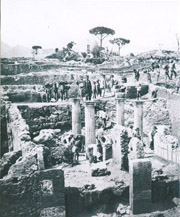
THE DISCOVERY OF POMPEII
In the XVI century Count Muzio Tuttavilla commissioned reclamation works in the Sarno river valley with the aim of digging a canal. During the excavations, the architect Fontana found some buildings with decorated walls in the area known as 'Collina della Civita'. This find was documented and left at that, and the works on the canal continued. Excavations in Pompeii began again in 1748 under the reign of Charles of Bourbon while the excavations already under way at Herculaneum were heralding sensational discoveries. The digs at Pompeii were a monumental effort, with resources channelled into the greatest excavation work ever carried out. With a few brief interruptions, it has continued up to the present day. As Herculaneum was covered by a mud slide, excavation work rnade better progress in Pompeii because it was much harder to remove the hardened blanket of solidified mud than it was to dig out Pompeii from the layers of ash and lapilli stones.
Interest in the research at Pompeii was given new vigour when many of the buildings around the Forum and some of the prestigious houses were found between 1806 and 1832.
In 1860 Giuseppe Fiorelli was appointed director of the archaeological site at Pompeii and he first introduced a methodology which combined discovery with the concept of conservation. This technique was applied to all the excavations in progress, which from then onwards were no longer single mindedly inspired by the sole desire to find precious objects and important buildings.
For the first time the wish to bring one of history's greatest towns back to life led to rational and well planned house to-house excavations. A digging technique, whereby excavations began at roof level and moved down towards the floor layer by layer, was introduced to prevent buildings from collapsing outwards onto the previously excavated roads.
An important phase of research followed between 1875 and 1893 under the direction of the architect Michele Ruggiero. Many insulae were uncovered as were numerous houses in the areas known as 'REGIO V’, 'REGIO VIII’ and 'REGIO IX’ but, more importantly, restoration work began on over five hundred fresco paintings found on the walls of the houses.
The works went through a delicate phase under the direction of Vittorio Spinazzola and excavations carried out between 1910 and 1924 focused on the southern areas of the town. The aim of this was to unearth the whole stretch of the main road, Via dell'Abbondanza, bringing to light the facades of the buildings along the road and joining the Amphitheatre to the Forum. This caused problems in containing the facades of the buildings as they were now under pressure from the large quantities of ash inside them.
Furthermore, the fact that researchers continually found interesting items meant that they would at times begin to dig into the insulae out of sheer curiosity and then abandon them. Thus today we find several houses that have been only partially excavated. Then came the archaeologist Amedeo Maiuri who was responsible for the discovery of many items between 1924 and 1961 and, above all, the author of numerous studies and fundamental interpretations. It is thanks to him that many important chapters have been written in the great book of archaeology that we call Pompeii.
Giuseppe Spano, a figure from the academic world who worked as the director of the archaeological digs during Maiuri's superintendency, was the author of many works that have helped in understanding the history of the settlements around Mount Vesuvius.
The contemporary period has been characterised not only by new discoveries, but also by serious problems regarding the preservation of what was found in the past (regardless of the state of the national economy the Italian State has shown great reluctance to spend public money in this sector ), and by the need to open up new chapters in the history of Pompeii as part of an interdisciplinary approach.






